14.7: Maxima/Minima Problems
( \newcommand{\kernel}{\mathrm{null}\,}\)
- Use partial derivatives to locate critical points for a function of two variables.
- Apply a second derivative test to identify a critical point as a local maximum, local minimum, or saddle point for a function of two variables.
- Examine critical points and boundary points to find absolute maximum and minimum values for a function of two variables.
One of the most useful applications for derivatives of a function of one variable is the determination of maximum and/or minimum values. This application is also important for functions of two or more variables, but as we have seen in earlier sections of this chapter, the introduction of more independent variables leads to more possible outcomes for the calculations. The main ideas of finding critical points and using derivative tests are still valid, but new wrinkles appear when assessing the results.
Critical Points
For functions of a single variable, we defined critical points as the values of the variable at which the function's derivative equals zero or does not exist. For functions of two or more variables, the concept is essentially the same, except for the fact that we are now working with partial derivatives.
Let
- Either
Find the critical points of each of the following functions:
Solution
a. First, we calculate
Next, we set each of these expressions equal to zero:
Then, multiply each equation by its common denominator:
Therefore,
We must also check for the possibility that the denominator of each partial derivative can equal zero, thus causing the partial derivative not to exist. Since the denominator is the same in each partial derivative, we need only do this once:
Equation
Therefore, any points on the hyperbola are not only critical points, they are also on the boundary of the domain. To put the hyperbola in standard form, we use the method of completing the square:
Dividing both sides by
Notice that point
Thus, the critical points of the function
b. First, we calculate
Next, we set each of these expressions equal to zero, which gives a system of equations in
Subtracting the second equation from the first gives
Therefore
Figure
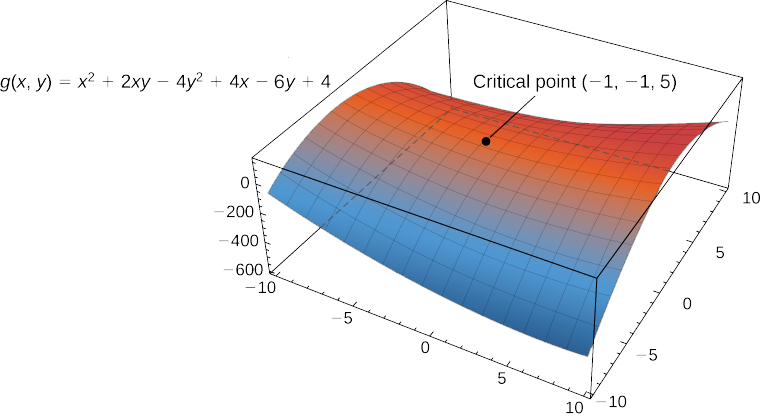
Find the critical point of the function
- Hint
-
Calculate
- Answer
-
The only critical point of
The main purpose for determining critical points is to locate relative maxima and minima, as in single-variable calculus. When working with a function of one variable, the definition of a local extremum involves finding an interval around the critical point such that the function value is either greater than or less than all the other function values in that interval. When working with a function of two or more variables, we work with an open disk around the point.
Let
for all points
The function
for all points
If
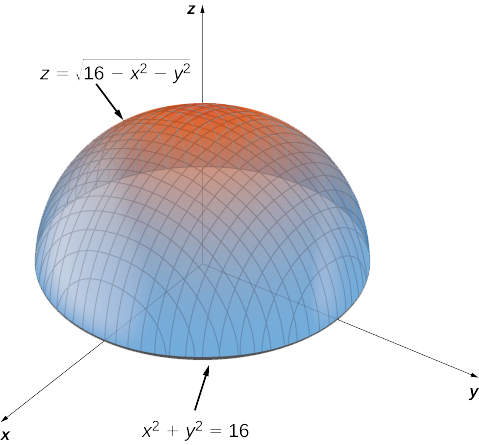
In Calculus 1, we showed that extrema of functions of one variable occur at critical points. The same is true for functions of more than one variable, as stated in the following theorem.
Let
Second Derivative Test
Consider the function
Figure
In this graph, the origin is a saddle point. This is because the first partial derivatives of f
Given the function
The second derivative test for a function of one variable provides a method for determining whether an extremum occurs at a critical point of a function. When extending this result to a function of two variables, an issue arises related to the fact that there are, in fact, four different second-order partial derivatives, although equality of mixed partials reduces this to three. The second derivative test for a function of two variables, stated in the following theorem, uses a discriminant
Let
Then:
- If
- If
- If
- If
See Figure

To apply the second derivative test, it is necessary that we first find the critical points of the function. There are several steps involved in the entire procedure, which are outlined in a problem-solving strategy.
Let
- Determine the critical points
- Calculate the discriminant
- Apply the four cases of the test to determine whether each critical point is a local maximum, local minimum, or saddle point, or whether the theorem is inconclusive.
Find the critical points for each of the following functions, and use the second derivative test to find the local extrema:
Solution
a. Step 1 of the problem-solving strategy involves finding the critical points of
Setting them equal to zero yields the system of equations
The solution to this system is
Step 2 of the problem-solving strategy involves calculating
Therefore,
Step 3 states to apply the four cases of the test to classify the function's behavior at this critical point.
Since
Figure
b. For step 1, we first calculate
Setting them equal to zero yields the system of equations
To solve this system, first solve the second equation for
Therefore,
Step 2 involves calculating the second partial derivatives of
Then, we find a general formula for
Next, we substitute each critical point into this formula:
In step 3, we note that, applying Note to point
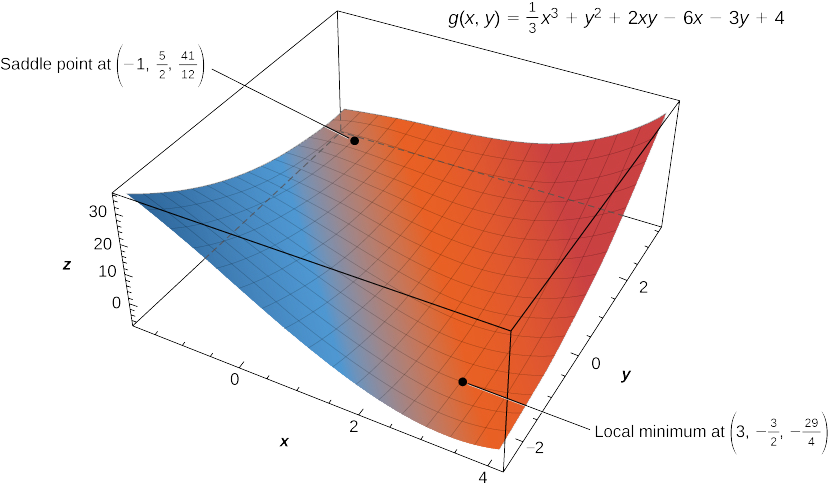
Use the second derivative test to find the local extrema of the function
- Hint
-
Follow the problem-solving strategy for applying the second derivative test.
- Answer
-
Absolute Maxima and Minima
When finding global extrema of functions of one variable on a closed interval, we start by checking the critical values over that interval and then evaluate the function at the endpoints of the interval. When working with a function of two variables, the closed interval is replaced by a closed, bounded set. A set is bounded if all the points in that set can be contained within a ball (or disk) of finite radius. First, we need to find the critical points inside the set and calculate the corresponding critical values. Then, it is necessary to find the maximum and minimum value of the function on the boundary of the set. When we have all these values, the largest function value corresponds to the global maximum and the smallest function value corresponds to the absolute minimum. First, however, we need to be assured that such values exist. The following theorem does this.
A continuous function
Now that we know any continuous function
Assume
- The values of
- The values of
The proof of this theorem is a direct consequence of the extreme value theorem and Fermat’s theorem. In particular, if either extremum is not located on the boundary of
Let
- Determine the critical points of
- Calculate
- Determine the maximum and minimum values of
- The maximum and minimum values of
Finding the maximum and minimum values of
If the boundary of the set
Use the problem-solving strategy for finding absolute extrema of a function to determine the absolute extrema of each of the following functions:
Solution
a. Using the problem-solving strategy, step
Setting them equal to zero yields the system of equations
The solution to this system is
The next step involves finding the extrema of
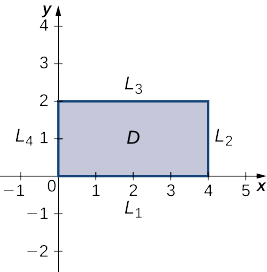
We also need to find the values of
The absolute maximum value is
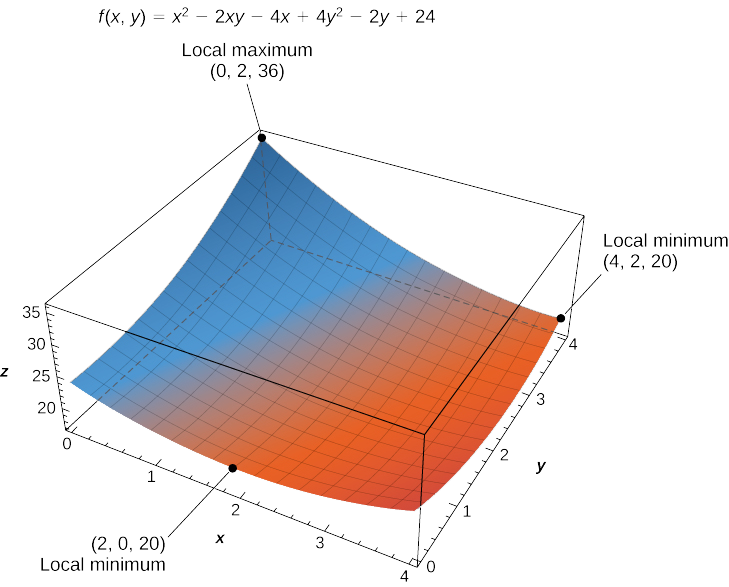
b. Using the problem-solving strategy, step
Setting them equal to zero yields the system of equations
The solution to this system is
The next step involves finding the extrema of g on the boundary of its domain. The boundary of its domain consists of a circle of radius
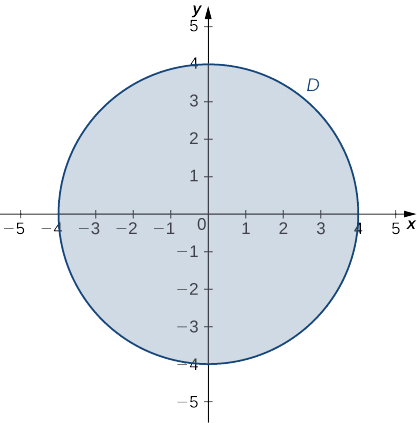
The boundary of the domain of
Setting
This equation has two solutions over the interval
Therefore,
For the second angle,
Therefore,
The absolute minimum of
Use the problem-solving strategy for finding absolute extrema of a function to find the absolute extrema of the function
on the domain defined by
- Hint
-
Calculate
- Answer
-
The absolute minimum occurs at
The absolute maximum occurs at
Pro-
where

Solution
Using the problem-solving strategy, step
Setting them equal to zero yields the system of equations
The solution to this system is
The domain of this function is
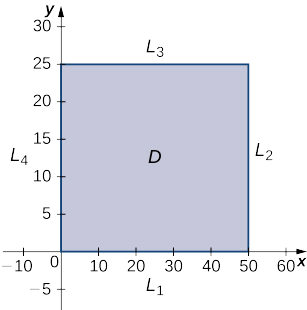
Setting
This function has a critical point at
This function has a critical point at
This function has a critical point at
We also need to find the values of
The maximum value is
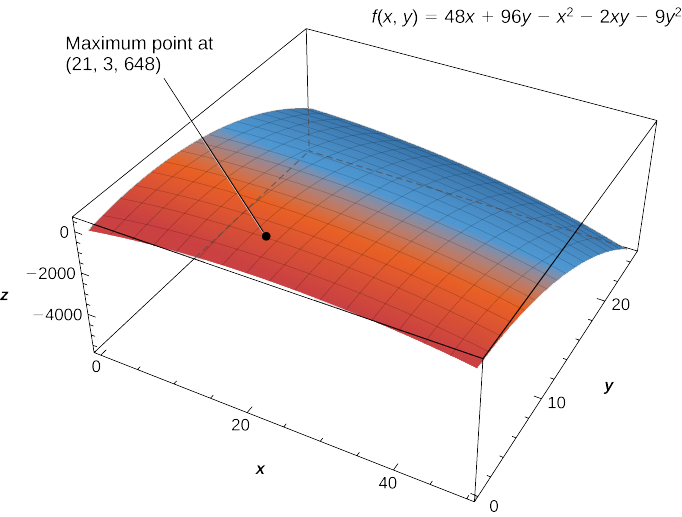
Key Concepts
- A critical point of the function
- A saddle point is a point
- To find extrema of functions of two variables, first find the critical points, then calculate the discriminant and apply the second derivative test.
Key Equations
- Discriminant
Glossary
- critical point of a function of two variables
-
the point
1.
2. At least one of
- discriminant
- the discriminant of the function
- saddle point
- given the function


